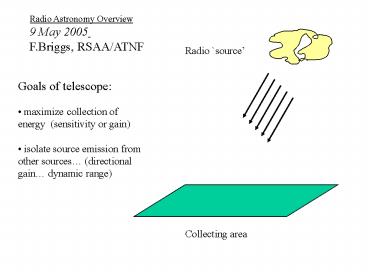Observational techniques... coordinates, RA intro - PowerPoint PPT Presentation
Title:
Observational techniques... coordinates, RA intro
Description:
Synthesis Imaging in Radio Astronomy, 1998, ASP Conf. Series, Vol 180, eds. ... Radio telescopes are Diffraction Limited. Incident waves ... – PowerPoint PPT presentation
Number of Views:23
Avg rating:3.0/5.0
Title: Observational techniques... coordinates, RA intro
1
Radio Astronomy Overview 9 May 2005 F.Briggs,
RSAA/ATNF
Radio source
- Goals of telescope
- maximize collection of energy (sensitivity or
gain) - isolate source emission from other sources
(directional gain dynamic range)
Collecting area
2
Login obstech passwd see me or Peter
3
(biblical status in field)
4
- More references
- Synthesis Imaging in Radio Astronomy, 1998, ASP
Conf. Series, Vol 180, eds. Taylor, Carilli
Perley - Single-Dish Radio Astronomy, 2002, ASP Conf.
Series, Vol 278, eds. Stanimirovic, Altschuler,
Goldsmith Salter - AIPS Cookbook, http//www.aoc.nrao.edu/aips/
5
ATCA
6
Parkes
The Dish
7
VLA, Very Large Array New Mexico
8
Arecibo Telescope in Puerto Rico
9
(No Transcript)
10
GBT Green Bank West Virginia the newest
and last (perhaps) big
dish Unblocked Aperture
11
LOFAR elements
12
Very Large Array USA
Westerbork Telescope Netherlands
13
VLBA Very Long Baseline Array for Very
Long Baseline Interferometry
14
EVN European VLBI Network (more and bigger
dishes than VLBA)
15
ESO Paranal, Chile
16
1) Thermal 2) Non-Thermal
Radio Sources Spectra
- Thermal
- emission mechanism related
- to Planck BB electrons have
- Maxwellian distribution
- 2) Non-Thermal
- emission typically from
- relativistic electrons in
- magnetic field electrons
- have power law energy
- distribution
Flux Density
Distinctive Radio Spectra !
Frequency MHz
17
Nonthermal
18
Thermal
M81 Group of Galaxies
Visible Light
Radio map of cold hydrogen gas
19
(from P. McGregor notes)
20
(No Transcript)
21
(No Transcript)
22
In where In Sn/W
can assign brightness temperature to objects
where Temp really has no meaning
23
Brightest Sources in Sky
Flux Density Jansky
Frequency MHz
(from Kraus, Radio Astronomy)
24
Radio source
- Goals of telescope
- maximize collection of energy (sensitivity or
gain) - isolate source emission from other sources
(directional gain dynamic range)
Collecting area
25
Radio telescopes are Diffraction Limited
26
Radio telescopes are Diffraction Limited
Waves arriving from slightly different
direction have
q
Phase gradient across aperture When l/2, get
cancellation
Resolution q l/D
27
Celestial Radio Waves?
28
Actually. Noise . time series
Time
Fourier transform
Frequency
29
F.T. of noise time series
Frequency
Narrow band filter B Hz
Frequency
Envelope of time series varies on scale t 1/B
sec
Time
30
thought experiment
Cartoon antenna
2 wires out
(antennas are reciprocal devices can
receive or broadcast)
31
thought experiment
Black Body oven at temperature T
32
thought experiment
R
33
thought experiment
wait a while reach equilibrium at T
R
warm resistor delivers power P kT B (B
frequency bandwidth k Boltzmann Const)
34
real definition
Measure Antenna output Power as Ta antenna
temperature
Ta
temp T
warm resistor produces P kT B Pa kTa B
35
Radio source
Reception Pattern or Power Pattern
Collecting area
36
Radio source
If source with brightness temperature Tb
fills the beam (reception pattern), then Ta
Tb
Collecting area
(!! No dependence on telescope if emission fills
beam !!)
37
receiver temperature
quantify Receiver internal noise Power as Tr
receiver temperature
Ta
Ampl, etc
Real electronics adds noise
treat as ideal, noise-free amp with added power
from warm R
TrTa
Ampl, etc
38
system temperature
quantify total receiver System noise power as
Tsys
include spillover, scattering, etc
TsysTa
Ampl, etc
RMS fluctuations DT DT
(fac)Tsys/(B tint)1/2
Fac 1 2 B Bandwidth, Hz tint integration
time, seconds
39
Radio point source
Power collected Sn Aeff B/2 Sn flux density
(watts/sq-m/Hz) 1 Jansky 1 Jy 10-26
w/sq-m/Hz Aeff effective area (sq-m) B
frequency bandwith (Hz) Ta Sn Aeff /2k
Collecting area
40
Resolved
Unresolved
Sn flux density Aeff effective area (sq-m)
Ta Sn Aeff /2k
If source fills the beam Ta Tb
RMS DT (fac)Tsys/(B tint)1/2
fac 1 2 B Bandwidth tint integration time
41
High Velocity HI Cloud NHI 1 x 1019 cm-2
Example 1
NHI 1.8 x 1018 Tb DV km/s 1.8 x 1018 Tb
(10) Tb 0.6 K
5 rms 5DT Tb 0.6 K rms DT (fac)Tsys/(B
tint)1/2 (1)(30)/(B
tint)1/2 tint (30/0.12)2/(50x103) 1.2
seconds
B (10/3x105)x1420x106 50 KHz
(To reach NHI 1 x 1017 cm-2 need 10,000 times
longer 3 hours)
42
Example 2
High redshift quasar with continuum flux
density Sn 100 mJy
(Ta Sn Aeff /2k)
Ka Ta / Sn Aeff /2k K/Jy 0.7 K/Jy
Parkes 10 K/Jy Arecibo 2.7
K/Jy VLA 300 K/Jy SKA
Parkes 100 mJy yields Ta 70 mK
64 MHz continuum bandwidth for receiver
5 rms 5DT Tb 0.07 K rms DT
(fac)Tsys/(B tint)1/2
(1)(30)/(B tint)1/2 tint (30/0.014)2/(64x106)
0.1 sec
43
Example 3 Array
High redshift quasar with continuum flux
density Sn 1 mJy
(Ta Sn Aeff /2k)
Ka Ta / Sn Aeff /2k K/Jy 0.7
K/Jy Parkes 6 x 0.1 0.6 K/Jy ACTA
rms DS (fac)(Tsys /Ka)/(B tint)1/2
ATCA (B128 MHz) 1 mJy 5 rms means DS 0.2
mJy
rms DS (fac)(Tsys /Ka)/(B tint)1/2
(1.4)(30/0.6)/(B tint)1/2 tint
(70/0.0002)2/(128x106) 16 min































